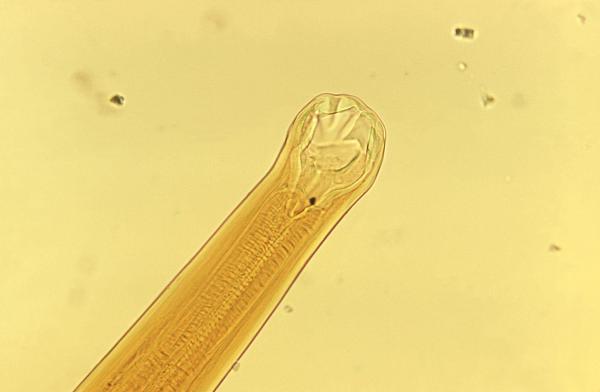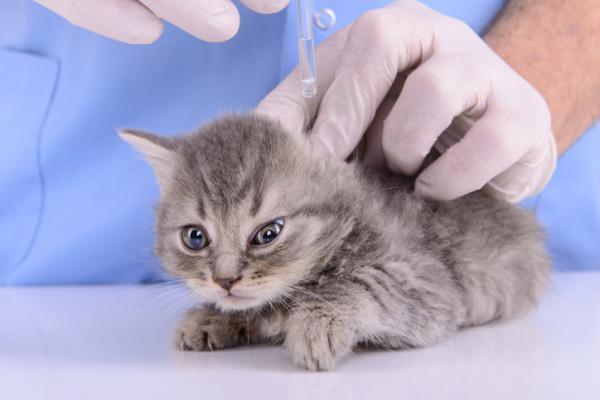Hookworms in Cats - Causes, Symptoms and Treatment



See files for Cats
Hookworms, similar to tapeworms and roundworms, are a group of blood-sucking parasites that can live in your cat's digestive system. They belong to the genus Ancylostoma. These parasites affect a wide variety of mammals, not only cats. They are known as ‘hook worms’ because of the hook-like mouth with which they anchor themselves to the intestinal walls.
Keep reading this AnimalWised article to know more about hookworms in cats, their possible causes, the most common symptoms, how to treat them and how to prevent them in the future.
What are hookworms in cats?
Feline hookworm infection is a parasitic disease caused by worms that belong to the Ancylostomatidae family, which includes several species. Cats are most commonly affected by Ancylostoma tubaeforme, Ancylostoma braziliense and Uncinaria stenocephala. In comparison to dogs, cats tend to harbor relatively few hookworms and these are generally less aggressive than the species found in dogs.
Cats become parasitized when the L3 larvae (third larval stage) enter their bodies. This can happen through ingestion, by penetrating their skin, or via the consumption of an infected mother's milk. The larvae settle in the feline's small intestine, and continue to develop until they reach their adult and final stage.
This kind of parasite has teeth to attach to the wall of your cat's small intestine, causing great damage to the intestinal mucosa. The disease often develops into a traumatic ulcerative enteritis, and the most common symptoms include anemia, progressive weakening and dramatic weight loss.

Causes of feline hookworms
Generally, warm and moist environments create the perfect conditions for the proliferation of hookworms, especially in areas where there is overcrowding and poor sanitation. Adult female hookworms lay thousands of microscopic eggs that end up in the cat's stool. The larvae will eventually hatch from the eggs and stay alive in the soil for weeks or months. The most common transmission routes are the following:
- Percutaneous: the larvae enters the body through the cat's skin in areas with no fur.
- Oral: it usually happens when the cat grooms its feet after they have been in contact with larvae.
- Breast milk: kittens become infected through the ingestion of milk from a parasitized mother.
In the case of cutaneous transmission, the L3 larva penetrates through the cat's skin, causing itchy dermatitis. The parasites will make their way to the lungs and trachea through the cat's bloodstream. Once in the lungs, the cat will likely cough up and swallow the larvae, making it easier for the parasite to reach their final destination, the small intestine. In scenarios where numerous parasites have entered the body, they can cause damage to the pulmonary alveoli and pneumonia.
Pathogenesis of hookworm in cats
Once the parasites reach the intestine, they will hook into the intestinal mucosa with their large toothed mouth. This will cause a traumatic intestinal inflammation, which causes the cat to start loosing blood. The parasites also secrete anticoagulant substances which prevent the blood from clotting, ensuring a constant stream of blood. This produces anemia and general weakness in the affected cat.
If you wish to know more about feline parasites, keep reading this article on the most common intestinal parasites in cats.
Symptoms of hookworms in cats
Most of the visible symptoms of feline hookworm are the consequence of the intestinal traumatic inflammatory process that begins once the parasites have hooked to the intestinal walls. These are the most frequent clinical signs that indicate that hookworms are affecting a cat:
- Dermatitis
- Itching in the paws
- Weight loss in adults
- Reduced growth in kittens
- Intestinal ulcers
- Bloody diarrhea
- Dehydration
- Malnutrition
- Progressive anemia
- Pale mucous membranes
- Tachycardia
- Respiratory insufficiency
- Poor coat quality
If you notice any of the clinical signs mentioned above, you should contact your veterinary immediately. Keep in mind that parasitized kittens are extremely susceptible, and these parasites can be very debilitating and deadly.

Diagnosis of hookworms in cats
It is possible to diagnose a hookworm infection before the appearance of the first symptoms through a parasitological test. Most of the symptoms mentioned above are nonspecific and can be attributed to various diseases or feline infections. However, if you notice any of these symptoms, it is important to take them to a veterinarian for diagnosis.
The most common parasitological test to detect this kind of parasite is performed through a technique called fecal flotation. This technique consists of mixing a small amount of the cat's stool with a special solution. This causes the hookworms eggs to float and adhere to a glass slide, where they can be easily identified through a microscope.
Keep reading this article to know more about home remedies for deworming cats.
Treatment of hookworms in cats
The first thing to do if a cat is affected by this parasitization, is to stabilize the cat. This is done by providing adequate nutrition, administrating fluid therapy to correct electrolyte imbalances or dehydration, and assessing whether a blood transfusion is necessary. A deworming medication called anthelmintic should also be administrated.
Most anthelmintics are able to kill the adult larvae, but are inefficient in treating the larvae in its early stages. In order for the treatment to be successful, more doses should be administrated every 2 weeks. This way, the medication is able to kill the adult larvae that matured after the previous treatment.

Prevention of hookworms in cats
The best way to prevent parasites in cats is through regular deworming.
In the case of pregnant cats, it is advisable to deworm them at the end of gestation in order to reduce the chances of transmitting the infection to the kittens through the milk. As for the kittens, they should be dewormed when they are 6 weeks old. The treatment should then be repeated every 2 or 3 weeks until they are 3 months old. From then on, it is recommended to perform a preventive internal and external deworming every 3 months.
Strict hygiene at home is especially important if the cat is allowed in and out of the house. Appropriate disposal of the cat feces is important as the stool should be removed from litter boxes daily.
Don't miss out on this article on the importance of deworming your pets.
Can humans get hookworms from cats?
Yes, feline hookworms are zoonotic, meaning they can be transmitted to people. Hookworms do not infect humans internally as they do in cats or dogs, but they can cause a skin disease called cutaneous larval migrans. This can only occur if humans come in contact with a parasitized cat or with litter contaminated by their feces. The infection causes mild dermatitis accompanied by an itching sensation. In some cases, curved or snake-shaped lesions might appear in the area where the larvae enter the skin.
This article is purely informative. AnimalWised does not have the authority to prescribe any veterinary treatment or create a diagnosis. We invite you to take your pet to the veterinarian if they are suffering from any condition or pain.
If you want to read similar articles to Hookworms in Cats - Causes, Symptoms and Treatment, we recommend you visit our Parasitic diseases category.
- P. Junquera. (2017). To ncylostoma spp, intestinal nematode worms of DOGS and CATS: biology, prevention and control. Ancylostoma caninum, Ancylostoma braziliense, Ancylostoma tubaeforme. Parasitipedia. Retrieved from: https://parasitipedia.net/index.php?option=com_content&view=article&id=1463&Itemid=1594
- Bowman, D. D. (2011). Georgis Parasitology for Veterinarians. 9th Edition. Elsevier.
- Ortiz, J. (2013). Hookworms and Hookworms in dogs and cats. Retrieved from: https://es.slideshare.net/heartagram/ancilostomiasis-y-uncinariasis-en-perros-y-gatos








